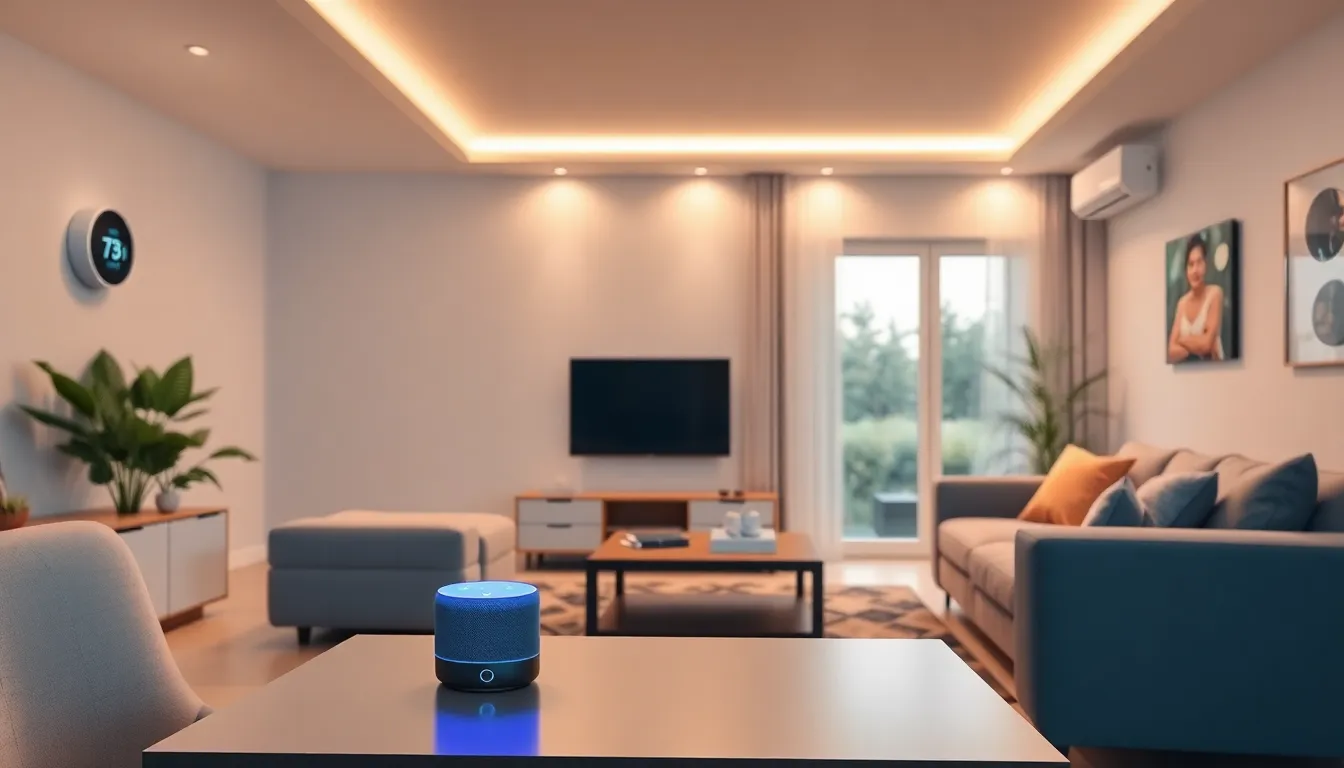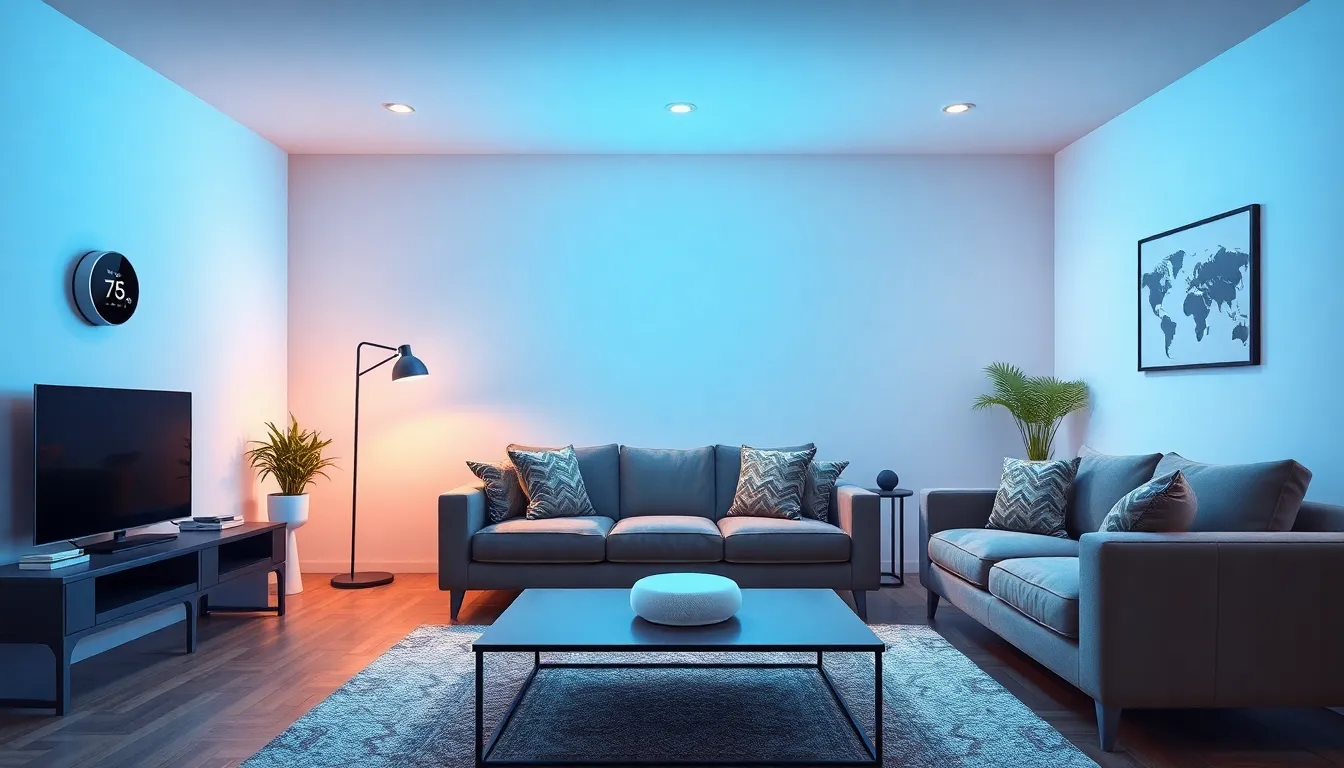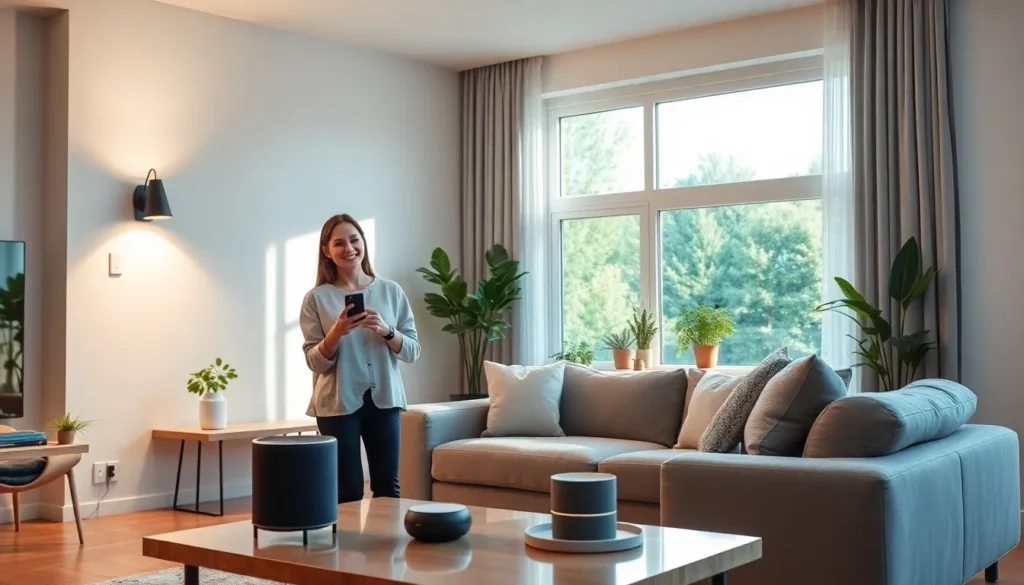Imagine waking up in a home that knows you better than your best friend. Smart living spaces are transforming the way people experience their homes, making everyday life feel like a scene from a sci-fi movie. With the power to control everything from lighting to temperature with just a few taps on a smartphone, these spaces are not just smart; they’re downright genius.
Gone are the days of fumbling for light switches or arguing over the thermostat. Instead, smart homes offer seamless integration and convenience, allowing people to focus on what really matters—like deciding whether to binge-watch that new series or finally tackle that laundry mountain. Dive into the world of smart living spaces and discover how technology can elevate comfort and efficiency, all while giving you that enviable “I have my life together” vibe.
Table of Contents
ToggleOverview of Smart Living Spaces
Smart living spaces represent a transformative approach to home management through the integration of advanced technology. These environments utilize interconnected devices that allow homeowners to control functions like lighting, temperature, and security easily. Users experience increased convenience while enjoying greater control over their living conditions.
Automation systems enhance daily routines. For example, smart thermostats adjust temperatures automatically based on user preferences or schedules. Additionally, intelligent lighting systems adapt to natural light levels, maximizing energy efficiency and comfort.
Home security also benefits from smart technology. Surveillance cameras, motion detectors, and smart locks enhance safety by providing real-time monitoring and alerts. These features empower homeowners to manage their security from anywhere using a smartphone or tablet.
Smart living spaces encourage energy conservation. Many devices track energy usage, offering insights that allow users to optimize consumption. With energy-efficient appliances and smart home features, individuals can reduce utility bills while minimizing environmental impact.
Organizational capabilities improve with smart technology. Voice-activated assistants can manage calendars, create shopping lists, and answer queries, streamlining various tasks. This results in a well-organized lifestyle that supports productivity.
Finally, the integration of smart technology fosters a connected community. Homeowners can share information about energy savings and security with neighbors, strengthening relationships and promoting sustainability. As smart living spaces continue to evolve, they enhance comfort and efficiency, creating a more enjoyable living experience.
Key Components of Smart Living Spaces


Smart living spaces feature essential components that enhance connectivity and functionality within the home. These elements streamline daily activities, increasing convenience and efficiency.
Smart Home Devices
Smart home devices play a crucial role in modern living. Smart thermostats regulate temperature based on user preferences, ensuring optimal comfort. Intelligent lighting systems adjust brightness and color according to natural light levels and time of day, improving ambiance. Home security systems, including surveillance cameras and smart locks, provide real-time monitoring to enhance safety. Voice-activated assistants manage tasks hands-free, facilitating productivity and organization. These devices work together seamlessly, creating a cohesive and user-friendly environment.
Automation Systems
Automation systems integrate various smart home devices for a more streamlined experience. Users can customize routines to perform tasks automatically, like adjusting lighting or temperature at specific times. Centralized control hubs allow easy management of all connected devices from one interface. These systems enhance energy efficiency by monitoring usage and turning off devices when not in use. Homeowners gain peace of mind with automatic alerts for security breaches or unusual activity, reinforcing safety. Ultimately, automation systems transform living spaces into intelligent environments that cater to individual lifestyles.
Benefits of Smart Living Spaces
Smart living spaces bring numerous advantages, elevating daily life through advanced technology integration. They provide a seamless experience, improving comfort and functionality.
Enhanced Convenience
Smart living spaces simplify home management. Automation allows users to control lighting, temperature, and appliances via smartphones. Voice-activated assistants streamline daily tasks, enabling hands-free management. Scheduling routines fosters consistency in everyday activities. Users can preset moods with intelligent lighting for different occasions, enhancing ambiance. Connected devices allow for remote monitoring, ensuring peace of mind while away from home. Real-time alerts notify users of unusual activities, further enhancing security. Overall, these conveniences lead to better organization and increased productivity.
Energy Efficiency
Energy efficiency benefits significantly from smart living spaces. These homes utilize smart thermostats to regulate heating and cooling, optimizing energy usage. Data collection from these devices helps identify patterns, enabling users to make informed decisions on consumption. Users can monitor energy usage through connected applications, increasing awareness of costs. Lighting systems adjust automatically based on natural light, conserving energy when unnecessary. Moreover, energy-efficient appliances reduce overall consumption, which lowers utility bills. Such features contribute not only to financial savings but also to a reduced environmental footprint.
Challenges and Considerations
Smart living spaces present several challenges and considerations that potential users must navigate.
Privacy and Security Concerns
Privacy and security issues frequently arise with smart technology. Connected devices collect vast amounts of personal data, leading to potential unauthorized access. Users often worry about cyber threats that can compromise home networks and sensitive information. Manufacturers regularly implement security measures; however, vulnerabilities still exist. Incidents of hacking can result in unauthorized control of home systems, such as cameras or smart locks. Regular software updates strengthen security but don’t eliminate all risks. Users must educate themselves about best practices for securing their devices, including the use of strong passwords and secure networks.
Implementation Costs
Implementation costs can deter individuals from adopting smart living technology. Initial investments for devices such as smart thermostats, cameras, and voice assistants accumulate quickly. High-quality products often command higher prices, adding to the total expenditure. Installation may also incur additional fees, particularly for complex systems. Budgeting for ongoing maintenance and updates remains essential, as many devices require periodic upgrades or subscriptions. Despite the upfront costs, energy savings and convenience can result in long-term financial benefits. Evaluating the return on investment can help users weigh the benefits against the expenses.
Future Trends in Smart Living Spaces
Integration of artificial intelligence into smart living spaces enhances user experiences and automates daily tasks. Devices equipped with AI can learn preferences, adapting settings for lighting or heating based on patterns observed. Multi-functional appliances are emerging, combining tasks to save space and increase efficiency, such as smart refrigerators that track expiration dates and suggest recipes.
Sustainability features are gaining popularity in smart homes. Manufacturers are focusing on energy-efficient designs that minimize waste and reduce environmental footprints. This involves using renewable energy sources and smart grids to create eco-friendly living environments.
Voice technology continues to evolve, offering more seamless interactions with smart devices. Enhanced natural language processing allows users to communicate with their homes in simple, conversational phrases. Smart assistants can not only respond to commands but also anticipate needs, providing suggestions based on routine behaviors.
Security innovations are becoming a critical focus. Advanced surveillance systems now incorporate facial recognition and movement detection to enhance safety. Real-time alerts and remote monitoring capabilities ensure users stay informed about potential threats even while away from home.
Furthermore, hybrid environments are integrating smart living spaces into shared communities. This trend promotes connected living, enabling residents to exchange services and information through digital platforms, fostering collaboration and enhancing communal safety measures.
Overall, these trends signify a shift towards more integrated, efficient, and environmentally conscious smart living spaces. The continuous evolution of technology presents exciting possibilities for enhancing everyday life through greater convenience, security, and sustainability.





